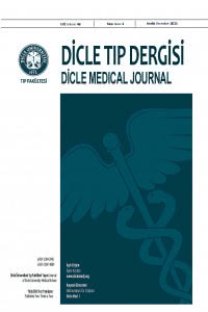Major Sitolojik Anormalliklerde Kolposkopik Histopatoloji Sonuçlarımız: Tersiyer bir Merkezde 5 Yıllık Deneyim
The Colposcopic Histopathology Results in Major Cytological Abnormalities: 5 Years Experience in a Tertiary Center
___
- 1.Bray F, Ferlay J, Soerjomataram I, et al . GlobalCancer Statistics 2018: GLOBOCAN Estimates ofIncidence and Mortality Worldwide for 36 Cancersin 185 Countries. CA Cancer J Clin. 2018; 68: 394-424.
- 2.Flanagan MB. Primary high-risk humanpapillomavirus testing for cervical cancer screeningin the United States: is it time? Arch Pathol Lab Med.2018; 142: 688-92.
- 3.Solomon D, Davey D, Kurman R et al. The 2001Bethesda System: terminology for reporting resultsof cervical cytology. JAMA. 2002; 287: 2114-19.
- 4.Perkins RB, Guido RS, Castle PE et al. 2019 ASCCPRisk-Based Management Consensus Guidelines forabnormal cervical cancer screening tests and cancer precursors. J Low Genit Tract Dis. 2020; 24: 102-31.
- 5.Ronco G, Dillner J, Elfström KM et al. Efficacy ofHPV-based screening for prevention of invasivecervical cancer: follow-up of four Europeanrandomised controlled trials. Lancet. 2014; 383:524-32.
- 6.Katki H, Schiffman M, Castle P et al. BenchmarkingCIN 3+ RISK as the basis for incorporating HPV andPap cotesting into cervical screening andmanagement guidelines. J Low Genit Tract Dis. 2013;17: 28-35.
- 7. Gultekin M, Zayifoglu Karaca M, et al. Initial resultsof population based cervical cancer screeningprogram using HPV testing in one million Turkishwomen. Int J Cancer. 2018; 142: 1952-58.
- 8.Turkish Cervical Cancer and Cervical CytologyResearch Group. Prevalence of cervical cytologicalabnormalities in Turkey. Int J Gynaecol Obstet. 2009;106: 206-9.
- 9.Arslan E, Gokdagli F, Bozdag H, et al. AbnormalPap smear frequency and comparison of repeatcytological follow-up with colposcopy duringpatient management: the importance ofpathologist’s guidance in the management. NorthClin Istanb. 2018; 6: 69-74
- 10.Wang SS, Sherman ME, Hildesheim A et al.Cervical adenocarcinoma and squamous cellcarcinoma incidence trends among white womenand black women in the United States for 1976-2000. Cancer. 2004; 100: 1035-44.
- 11.Boyraz G, Basaran D, Salman MC et al.Histological follow-up in patients with atypicalglandular cells on Pap smears. J Cytol. 2017; 34: 203-7.
- 12.Toyada S, Kawaguchi R, Kobayashi H.Clinicopathological Characteristics of AtypicalGlanduler Cells Determined by Cervical Cytology inJapan: Survey of Gynecologic Oncology DATA FromThe Obstetrical Gynecological Society of KinkiDistrict, Japan. Acta Cytol. 2019; 63: 361-70.
- 13.Kim SS, Suh DS, Kim KH, et al. Clinicopathologicalsignificance of atypical glandular cells on Pap smear.Obstet Gynecol Sci. 2013; 56: 76‑83.
- 14.Mood NI, Eftekhar Z, Haratian A, et al. Acytohistologic study of atypical glandular cellsdetected in cervical smears during cervicalscreening tests in Iran. Int J Gynecol Cancer. 2006;16: 257‑61.
- 15.Wang J, Andrae B, Sundström K et al. Risk ofinvasive cervical cancer after atypical glandular cellsin cervical screening: nationwide cohort study. BMJ.2016; 352, i276.
- 16.Wright TC, Cox JT, Massad LS et al. 2001consensus guidelines for the management of womenwith cervical intraepithelial neoplasia. Am J ObstetGynecol. 2003; 189: 295-304.
- 17.Quddus MR, Sung CJ, Steinhoff MM, et al. Atypicalsquamous metaplastic cells: reproducibility,outcome, and diagnostic features on ThinPrep Paptest. Cancer Cytopathol. 2001; 93: 16-22.
- 18.Ortashi O, Abdalla D. Colposcopic andHistological Outcome of Atypical Squamous Cells ofUndetermined Significance and Atypical SquamousCell of Undetermined Significance Cannot ExcludeHigh-Grade in Women Screened for Cervical Cancer.Asian Pac J Cancer Prev. 2019; 20: 2579-82.
- 19.Gupta S, Sodhani P, Chachra K, et al. Outcome of“Atypical squamous cells” in a cervical cytologyscreening program: implications for follow up inresource limited settings. Diagn Cytopathol. 2007;35: 677-80.
- 20.Kietpeerakool C, Tangjitgamol S, Srisomboon J.Histopathological outcomes of women withabnormal cervical cytology: a review of literature inThailand. Asian Pac J Cancer Prev. 2014; 15: 6489-94.
- 21.Selvaggi S. Clinical significance of atypicalsquamous cells cannot exclude high gradesquamous intraepithelial lesion with histologiccorrelation-: a 9-year experience. Diagn Cytopathol. 2013; 41: 943-6.
- 22.Kingnate C, Tangjitgamol S, Khunarong J, et al.Abnormal uterine cervical cytology in a largetertiary hospital in Bangkok metropolis: Prevalence,management, and outcomes. Indian J Cancer. 2016;53: 67-73.
- 23.Xu L, Verdoodt F, Wentzensen N, et al. Triage ofASC-H: A meta-analysis of the accuracy of high-riskHPV testing and other markers to detect cervicalprecancer. Cancer Cytopathol. 2016; 124: 261-72.
- 24.Sung CO, Oh YL, Song SY. Cervical cytology ofatypical squamous cells, cannot exclude high-gradesquamous intraepithelial lesion: significance of age,human papillomavirus DNA detection and previousabnormal cytology on follow-up outcomes. Eur JObstet Gynecol Reprod Biol. 2011; 159: 155-9.
- 25.Sherman M, Castle P, Solomon D. Cervicalcytology of atypical squamous cells–cannot excludehigh-grade squamous intraepithelial lesion (ASC-H)characteristics and histologic outcomes. Cancer.2006; 108: 298-305.
- 26.Erdoğdu İH. Comparison Of The PathologicalMaterials With Hpv Results In Patients WithMolecular Hpv. Dicle Med J. 2019; 46: 167-72.
- 27.Demarco M, Egemen D, Raine-Bennett TR et al. Astudy of partial human papillomavirus genotyping insupport of the 2019 ASCCP risk-based managementconsensus guidelines. J Low Genit Tract Dis. 2020;24: 144-7.
- 28.Huitron S, Bonvicino A, Fadare O. Patients withnegative cervical biopsies after papanicolaou testinterpretations of “atypical squamous cells, cannotexclude high-grade squamous intraepitheliallesion”: comparative longitudinal follow-up. AnnDiagn Pathol. 2008; 12: 187-90.
- ISSN: 1300-2945
- Yayın Aralığı: 4
- Başlangıç: 1963
- Yayıncı: Cahfer GÜLOĞLU
Maraş Otunun Ağrı Şiddeti, Ağrı Eşiği ve Ağrı Toleransı Üzerine Etkisi
Nurten SERİNGEÇ AKKEÇECİ, Can ACIPAYAM
What Do Medical Students Think About HIV/AIDS? Student thoughts on HIV / AIDS
Lumbal Disk Hernili Hastalarda Hastalık Evresi Postüral Kontrolü Etkiler Mi?
Melda Soysal TOMRUK, Alp Tunca YAPICI, Nihal GELECEK, Orhan KALEMCİ
A Rare Cause of Hydronephrosis: Retrocaval ureter
The Relationship Between IgA Vasculitis and Antioxidant Activity In Children
Hayrettin TEMEL, Cihangir AKGÜN, Mesut OKUR
Seyhun SUCU, Çağdaş DEMİROĞLU, Özge KARUSERCİ, Muhammet Hanifi BADEMKIRAN, Emin SEVİNÇLER, Hüseyin ÖZCAN
Cihat UZUNKÖPRÜ, Enise Nur ÖZLEM TİRYAKİ, Muhammed Mücahit TİRYAKİ
Dilek AYGÜL KEŞİM, Mustafa KELLE, Hüda DİKEN, Hacer KAYHAN, Engin DEVECİ, Figen KOÇ DİREK, Cihan GÜL
